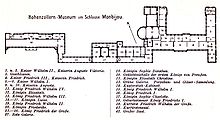Monbijou Palace
This article needs additional citations for verification. (June 2015) |
| Monbijou Palace | |
|---|---|
 Engraving of Monbijou Palace (1703) by Johann Christoph Böcklin | |
| Alternative names | Hohenzollern Stadtschloss, Monbijou Castle, Schloss Monbijou |
| General information | |
| Architectural style | Rococo, late-Baroque |
| Coordinates | 52°31′23″N 13°23′49″E / 52.52306°N 13.39694°E |
| Completed | 1706 |
| Demolished | 1959 |
| Design and construction | |
| Architect(s) | Eosander von Göthe |
Monbijou Palace was a
Beginnings
In the
In 1649,
Count von Wartenberg, his chief minister and favorite, was the developer of a "pleasure house", a small palace of just 400 square meters, erected by the royal architect Eosander von Göthe between 1703 and 1706 in a late Baroque style. Friedrich I presented it to Countess Wartenberg, his mistress.
Residence of queens

From 1712 the little palace served as the summer residence of
The palace was long uninhabited after the death of Queen Sophie Dorothea in 1757. In 1786 it became the chief residence of Queen
Hohenzollern Museum

Around 1820, the so-called "Germanic-Slavic Antiquities" were removed from the royal curiosities cabinet (Kunstkammer) and housed in Monbijou Palace as the Museum for National Antiquities (Museum für Vaterländische Alterthümer).

The museum survived the abolition of the monarchy in Germany in 1918. Its inventory remained in the possession of the dynasty but it was administered by the state, which made Monbijou Palace available for the purpose and assumed responsibility for maintaining the museum in the traditional way. World War II brought this state of affairs to an end. Large parts of the collections had been evacuated, and after the war were looted and brought to the Soviet Union and other places.
As late as 1940/41
War damage and demolition
As a precaution, all the palace windows had already been bricked up in 1940, but the entire building was gutted during an air raid in November 1943 and almost entirely destroyed. The ruins were left in place until 1959, when the East Berlin Magistrate—against the strenuous objection of museum professionals and parts of the
See also
References
- ^ Schloss Monbijou, Hohenzollernmuseum: Amtliche Führer. Berlin: Deutscher Kunstverlag. 1930.
- ^ "About us", on: St George's Anglican Episcopal Church, Berlin, retrieved on 14 May 2012.
- ^ a b c "St. George's Anglican Church" Archived 2011-01-03 at the Wayback Machine, on: Preussen.de Archived 2017-06-27 at the Wayback Machine, retrieved on 14 May 2012
- ^ "Graphic Arts Collection". Stiftung Preußische Schlösser und Gärten Berlin-Brandenburg (SPSG). Retrieved 2020-12-23.
- ^ Chazan, Guy (2020-12-15). "Berlin museum reignites debate over Germany's colonial past". Financial Times. Retrieved 2020-12-23.
The forum is a reconstruction of the Hohenzollern Stadtschloss, or city palace, home to the Kings of Prussia and later the Kaisers of the German Reich. Considered one of Germany's finest Baroque buildings, it was destroyed in Allied bombing raids in 1945 and its remains flattened by the East German communists in the 1950s.



